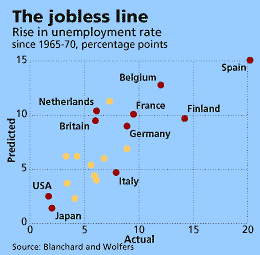Svegfors
SvD
Home
The Economist, 99-06-05
A shocking error
Europe’s high unemployment is often blamed on structural rigidities alone. That is a mistake
Finland's finance minister recently made a bold promise to Europe’s 16m unemployed. His country’s presidency of the European Union, which starts on July 1st, will be almost unique: it will be marked by no new job-creation schemes.
Perhaps none will be needed. That must be the hope of the EU leaders who launched their latest plan to get the jobless back to work at a summit in Cologne on June 3rd-4th. It involves voluntary job-creation targets and “macroeconomic dialogue” between companies, unions, governments and the European Central Bank. Maybe this will miraculously dent the dole queues. But don’t count on it.
Or perhaps a touch of reflation might help to ease the unemployed back into jobs. The ECB could trim interest rates and EU governments could give their economies a fiscal boost: both would stimulate employment. But the ECB says no more interest-rate cuts are in the pipeline. And it is insisting on tight fiscal policies to conform with the EU’s “growth and stability pact”, which limits governments’ budget deficits to 3% of GDP. Europe’s high unemployment, the central bankers declare, is nothing to do with macroeconomic policy: it is solely a “structural” problem.
This is nonsense. Some of Europe’s unemployment is cyclical, meaning that it could be cut by faster economic growth without sparking inflation. For example, Germany’s unemployment rate is 10.6%. The IMF estimates its structural rate at 8.9%. Faster growth could reduce the gap. Even so, the bulk of Europe’s unemployment is structural. So is the ECB right to say that macroeconomic policy cannot affect it?
Well actually, no. Europe’s high structural unemployment cannot be blamed on labour-market rigidities alone. Its labour markets were as just as ossified 20 years ago, if not more so; yet joblessness was then far lower. However, there is a danger that, when labour markets are gummed up, a cyclical rise in unemployment can turn into a structural one - making it impervious to an economic upturn. For example, strict employment-protection laws make it hard for workers who lose their jobs to find new ones. The longer they stay unemployed, the more their skills rust and the less employers are likely to hire them; some may give up looking altogether. Unable to compete effectively for jobs, they no longer help restrain pay demands: they have become “structurally” unemployed. So the ECB’s insistence that macroeconomic policy cannot affect joblessness could produce higher structural unemployment.
New research by Olivier Blanchard of the Massachusetts Institute of Technology and Justin Wolfers of Harvard University "The Role of Shocks and Institutions in the Rise of European Unemployment: the Aggregate Evidence", obtainable from http://web.mit.edu/blanchar/www/ confirms this.
Many studies have sought to explain Europe’s high unemployment, but theirs is the first to quantify the impact of the interaction of economic shocks with labour-market rigidities over time. It examines the role of eight labour-market rigidities - such as the length and generosity of unemployment benefits, the degree of employment protection, the payroll-tax burden and the centralisation of wage bargaining. It does this using figures from 20 countries (the 15 EU members plus America, Canada, New Zealand, Australia and Japan) over eight five-year periods, from 1960-65 to post-1995.
Messrs Blanchard and Wolfers perform two tests.
First, they assume that all 20 countries are hit by common but unobservable shocks. They track how unemployment has changed over time in the sample as a whole, and then they look at how its evolution differs across countries, according to how rigid their labour markets are. They find that a country with an average level of all eight labour-market rigidities would have seen a rise in unemployment of 7.2 percentage points since 1960. But joblessness would have risen twice as much in the country with the strictest employment-protection laws as in the one with the laxest. The country with the most generous unemployment benefits would have seen joblessness rise nearly five times as much as the one with the stingiest. And a country with highly co-ordinated wage bargaining would have seen a fourfold bigger rise in unemployment than one with highly decentralised bargaining. This model predicts rather well what actually happened country-by-country (see chart).

Next, the two economists assume that the sample economies are affected by observable, country-specific shocks. They identify three. Annual productivity growth has fallen sharply in most countries since 1960. The average has declined from around 5% to around 2%; this has added 1.3 percentage points to the unemployment rate.
Second, real (inflation-adjusted) interest rates have shot up over the past 20 years.
Where they have risen by five percentage points, the jobless rate has gone up by three. Third, the demand for labour has fallen since the mid-1980s as technological change reduced the need for unskilled workers and as companies have restructured.
In France and Spain the share of GDP going to labour has fallen by a tenth: this has boosted their jobless rates by around two percentage points. As in their first test, Messrs Blanchard and Wolfers find that labour-market rigidities are magnifying the effect of shocks - even more so in this case.
This is by no means the last word on the causes of Europe’s unemployment. The authors admit there are problems with some of their results. But the lessons for Europe are clear enough.
Labour markets do need to be more flexible if Europe’s jobless are to get back to work.
But until labour markets are freed, tight macroeconomic policy is one of those shocks that can only make things worse.